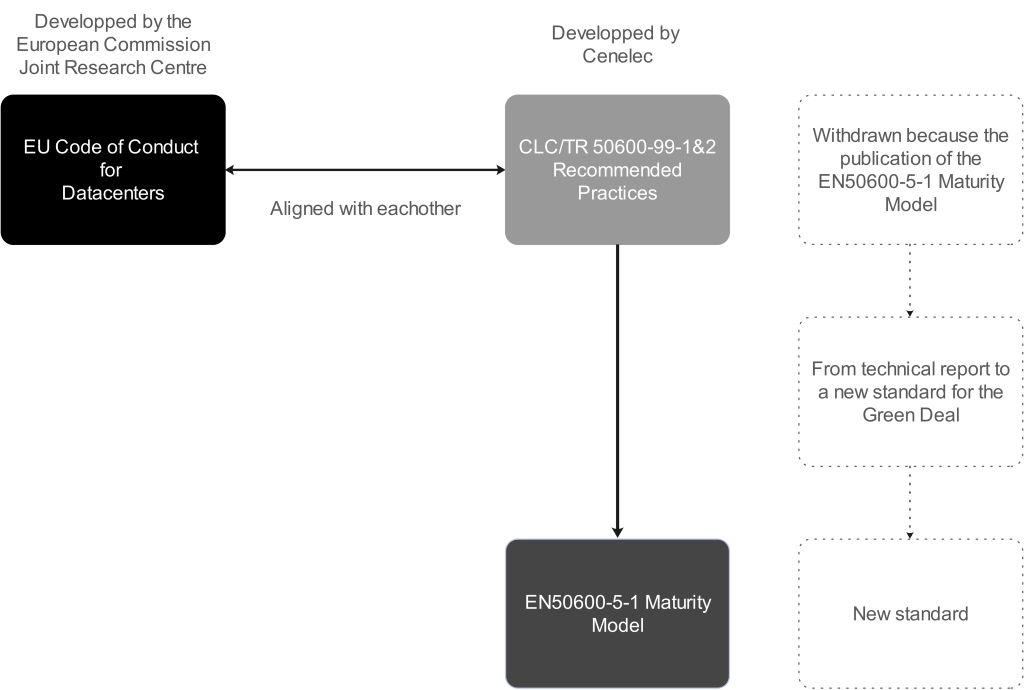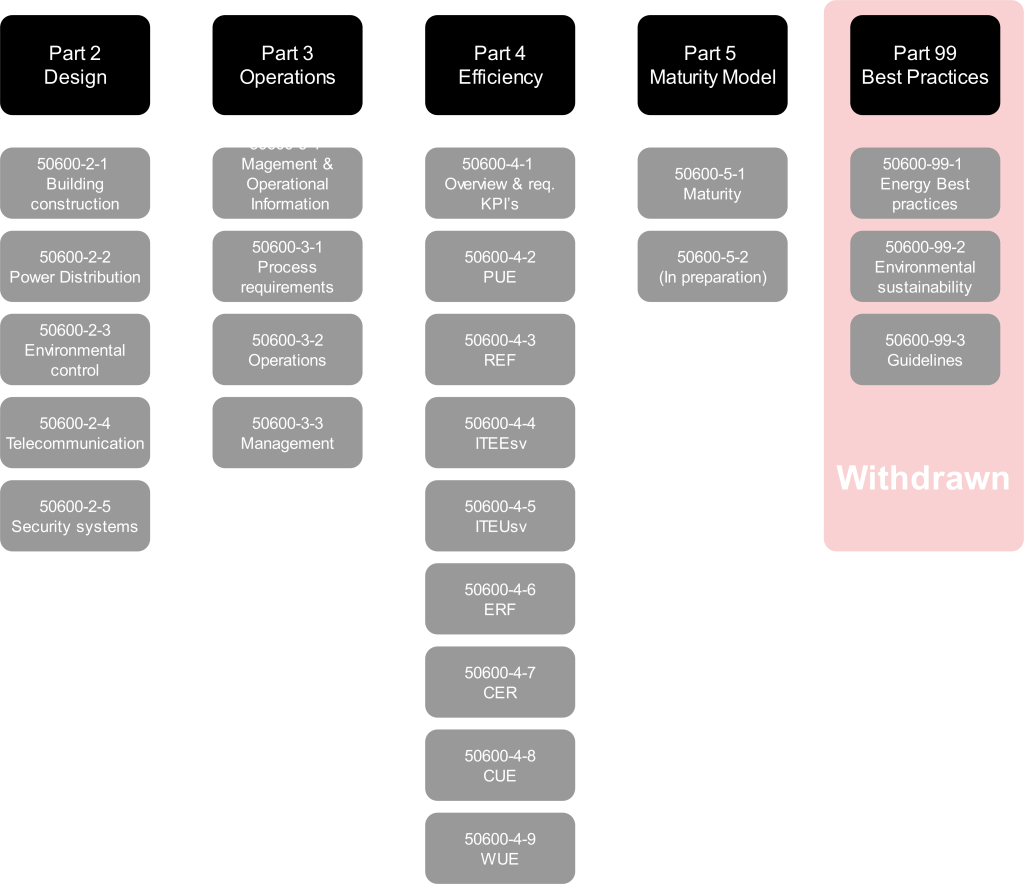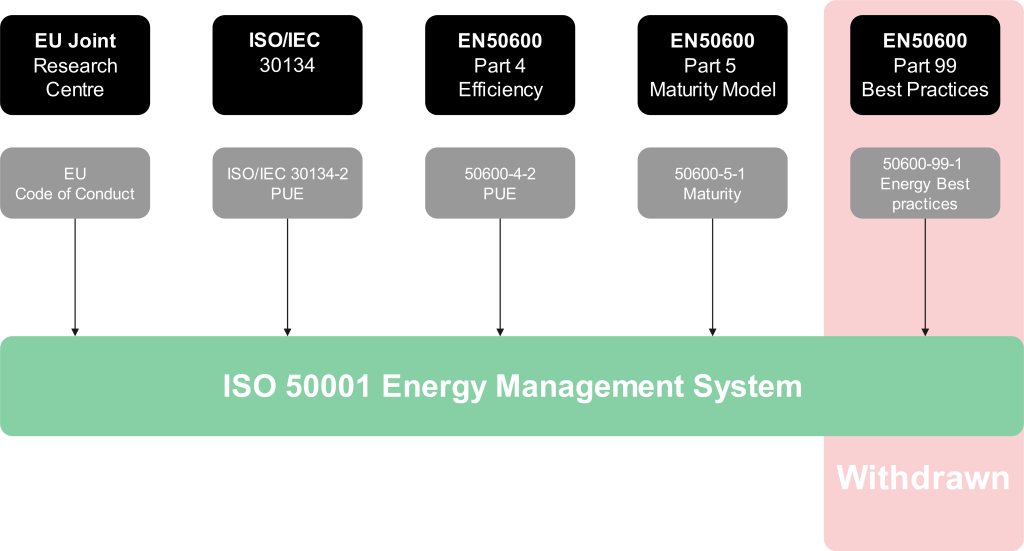Data center standards
Table of contents
- History
- ISO/IEC 30134 | Key Performance indicators
- Maturity Model for Energy Management and Environmental Sustainability
- EN 50600
- Relationship between the EN50600-4 and the ISO/IEC 30134
- Relationship with the ISO 50001 Energy Management System
- ISO 50001 as a solution
- ENERGY STAR Score for Data Centers
History
The data center industry is a relatively new industry, but due to its enormous growth, this new industry does have a major impact on energy consumption, for example.
In 2007, the non-profit organization The Green Grid was founded. In the years after, The Green Grid developed multiple data center metrics to determine the efficiency.
The Green Grid has transferred the metrics PUE, WUE & CUE they developed to the ISO/IEC JTC 1/SC 39 Sustainability, IT and data centers committee which were subsequently further developed, and some other metrics were developed by this committee.
ISO/IEC 30134 | Key Performance indicators
Workgroup 1 of the ISO/IEC JTC 1/SC 39 owns and develops new ISO/IEC 30134 Information technology | Data centres | Key performance indicators
The ISO/IEC 30134 provides a range of Key Performance Indicators (KPIs) for both the data center as well as the customer IT equipment.
Objectives of the ISO/IEC 30134:
- Minimization of the energy and other resource consumption
- Maximalization of the customer IT task effectiveness within the data center
- Energy re-use in the form of waste heat
- Use of renewable energy
The KPIs of the ISO/IEC 30134 are designed to be applicable for all types of data centers, technology neutral and geographically neutral.
This ISO/IEC 30314 currently covers the following standards:
Note: Some parts have amendments that are not shown here
I am currently leading the developing of a white paper containing a visualization into the various key performance indicators in the data center.
Maturity Model for Energy Management and Environmental Sustainability
In addition to the various Key Performance Indicators that show how efficient a data center is, it can also be determined how “mature the data center is”
The workgroup CLC/TC215/WG3 within the European standards institute CEN CENELEC recently published the CLC/TS 50600-5-1:2023 Information technology – Data centre facilities and infrastructures – Part 5-1: Maturity Model for Energy Management and Environmental Sustainability
This document provides a maturity model addressing the environmental impact (energy management and environmental sustainability) of the facilities, infrastructures and the information and communication technology (ICT) equipment accommodated by the data centre.
The CLC/TS 50600-5-1 is based on the following to documents:
- European Code of Conduct for Data Centres Best Practices
- CLC/TR 50600-99-1:2021 Recommended practices for energy management which has been withdrawn because of the publication of the CLC/TS 50600-5-1:2023

For more information about the CLC/TS 506000-5-1 Maturity model, please check this publication by CEN/Cenelec
EN 50600
EN 50600 is a European standard for data centers that provides comprehensive specifications for the planning, construction, and operation of these critical facilities.
Here are some key points about EN 50600:
- Holistic Approach: EN 50600 takes a holistic approach, covering various aspects of data center development. It defines requirements for trades, building construction, electrical supply, air conditioning, cabling, and security systems Efficiency KPI’s and the Maturity Model.
- European Coordination: The standard was developed through a Europe-wide standardization and coordination process by the European Committee for Electrotechnical Standardization (CENELEC).

Relationship between the EN50600-4 and the ISO/IEC 30134
In general the European EN50600-4 are almost identical to the International ISO/IEC 30134 standards.
The PUE, REF, ERF, CER, CUE, WUE are the metrics with focus on the data center infrastructure and the ITEEsv and ITEUsv are the metrics for IT efficiency.

Relationship with the ISO 50001 Energy Management System
ISO 50001 is based on the management system model of continual improvement also used for other well-known standards such as ISO 9001 or ISO 14001. This makes it easier for organizations to integrate energy management into their overall efforts to improve quality and environmental management.
ISO 50001 provides a framework of requirements for organizations to:
- Develop a policy for more efficient use of energy
- Fix targets and objectives to meet the policy
- Use data to better understand and make decisions about energy use
- Measure the results
- Review how well the policy works, and
- Continually improve energy management.
Source: https://www.iso.org/iso-50001-energy-management.html
Implementation of ISO 50001 in data centers result in:
- Creating awareness for energy efficiency
- Unified structure of measurement and reporting on energy PUE
- Continuous improvement on PUE setting PUE targets
- Regular energy audits
- Identification of significant energy users/components
- Majority of the data center organizations report the PUE in their annual sustainability reports which has a competitive component
- Regulatory compliance

ISO 50001 as a solution
The ISO 50001 can be the solution to become more energy efficient without creating a burden for the data center industry using the PUE for continuous improvement. However, the ISO 50001 is very high level and making the EU Code of Conduct tasks part of the assessment will bring the ISO 50001 to the next level
The ISO 50001 is already applied by many data center organizations.
Both the EU Code of Conduct and the ISO 50001 aim for energy savings in data center infrastructures.
ENERGY STAR Score for Data Centers
The Energy Star score for data centers is a self-assessment results-based certification that assesses how efficiently a data center uses energy like other data centers which uses the PUE is the standard metric.
Portofolio manager
The certification proces makes use of online reporting tool Portfolio manager.
This tool takes energy related data and provides a rating based upon a 1-100 energy performance scale. A score of 75 or higher means that you are in the top 25% of data centers for energy efficiency.
- There are no fees for certification.
- The certification is awarded for a specific year and must be renewed annually.
Requirements to be met:
- Over 50% of the building’s gross area must be used for data center purposes.
- Each space must meet certain minimum and maximum thresholds for key operating characteristics.
- Energy consumption data for IT loads and the total building must be gathered in kilowatt-hours for 11 consecutive months for all active meters. This data must yield a score of 75 or higher in the Portfolio Manager to qualify.
For more information please check the technical reference
Energy Star for Datacenters & ISO 50001 comparison table
| Description | Energy Star for Data centers | ISO 50001 |
|---|---|---|
| System | Online portal | Energy Management System |
| Goal | Decrease of energy usage | Decrease of energy usage |
| Process | Annual data upload in portal | Plan Do CheckAct |
| Key Performance Indicator | Power Usage Effectiveness (PUE¹²) | Power Usage Effectiveness (PUE¹²) |
| Recognition | US EPA driven program | International standard |
| Certification | Self assessment | Independent auditor outside ISO |
| Results of certification | Actual level of energy performance | No rating like Energy Star, Energy Management in place |
| Focus | Energy management | Energy management |
Energy Star for data centers is not related to the usual known Energy Star for IT equipment.
Summary
With the Energy Star for data centers, a score can be achieved that shows how the data center compares to other data centers (question would be how many and how dated this dataset is) on PUE.
The ISO 50001 is an energy management system is a process of continuous improvement.
